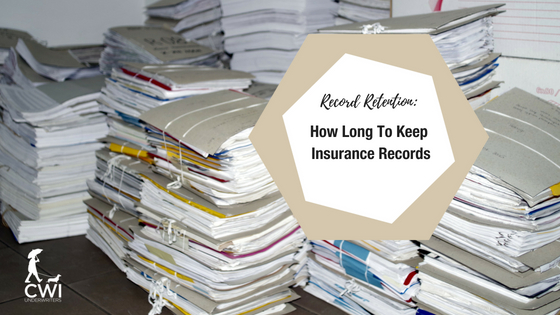Companies can build up a substantial collection of records over their years in operation. While nobody wants to be stuck holding onto documents that have outlived their usefulness, throwing away a document only to find out later that you need it can be a costly mistake. Insurance paperwork is particularly problematic—many businesses are unsure of what they should keep and what they can safely send to the shredder.
Records Retention Program
The simplest way for a company to manage all the records it acquires is to institute a records retention program that defines how long documents are to be kept. The program should specifically define the different types of records your company works with and how each should be treated. Creating a standard will help ensure that the documents you need will be there when the time comes and that any unnecessary clutter will be kept to a minimum.
Retain Based on Policy Types
Given all the different elements involved with running a business, your company has likely carried a variety of insurance coverages over its lifetime. Since each may come into play differently in the future, the type of plan you’re dealing with is crucial when figuring out what should be saved and what can be tossed.
- Occurrence-based Policies
Essentially active forever, occurrence-based policies cover any loss that occurred during the policy term, no matter when the claim is made. It is not unusual for these claims to happen decades later after an unknown side effect of company practices has been discovered. Even if processes have changed, a company may be held responsible for their past actions. An example of this is manufacturers who produced asbestos-containing products that where later shown to present a health hazard. If these manufacturers had an occurrence-based policy in effect during the time it was making such products, companies would be covered by the policy even if it had since expired.
Occurrence-based policies have the potential to save you from claims in the future that are completely unforeseeable by you today. Because of their long-term protection, these policies should be kept indefinitely.
- Property Policies
Property policies provide coverage for companies in the event there is a loss involving their owned, rented or leased property. Like occurrence-based policies, property policies cover any claim that involves a loss that occurred during the term of the policy. However, unlike occurrence-based policy claims, property losses are usually discovered shortly after they occur, limiting how long policy records need to be kept. For such policies, a
retention period of six years should adequately cover the chance for claims.
- Claims-made Policies
Claims-made policies cover claims that are made while the policy is active and, depending on the individual characteristics of the policy, may also include a “tail” that extends coverage for a set period after the policy expires. The tail only covers a claim if it is the result of a loss that occurred during the time when the policy was initially active. The policy’s coverage is based on when a claim is filed and not on the date when the loss occurred. Because there is a limited chance that they will come into play in the long term, six years after the tail expires is an adequate retention period for claims-made policies.
- Workers’ Compensation
Time has no effect on an employer’s liability for employee injury. There are many cases where employees are exposed to health hazards that take years to fully develop into a serious condition. This occurs frequently with mining companies whose operations exposed employees to hazardous coal dust before its relation to the development of Black Lung Disease was known. These companies are still responsible for the exposure no matter how long ago it happened. In these cases, the policy that was in effect at the time can also be triggered to cover the claim. For these reasons, it is important to keep records of workers compensation policies indefinitely.
- Employee Benefit Plans
Employee benefits are regulated by the Employee Retirement and Income Security Act of 1974 (ERISA). In Section 107, the Act contains a general records retention regulation that applies to any plan that falls under the ERISA. The regulation requires records to be kept for at least six years after their filing date.
While the wording of the regulation does not specifically target the policies themselves, for safety’s sake, it is
advised that insurance policy records for employees be kept at least six years to ensure federal compliance.
Retaining the right documents can make life much easier if a claim is filed. While there are limited federal requirements for record retention, the real benefit for a company is ensuring that claims are covered by the appropriate policies to limit any out-of-pocket expense. Evaluate your individual situation before developing your record retention policy. Remember, these are just suggested time frames for document retention—if you feel that your company may need to keep certain records longer, don’t hesitate to do so.



